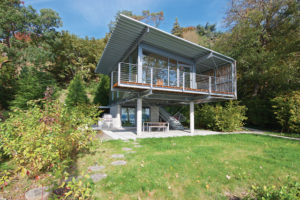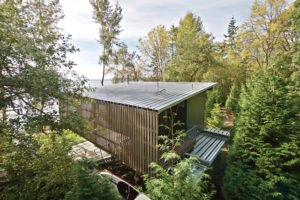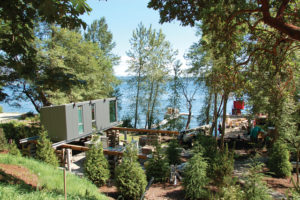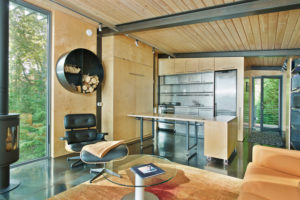Everyone appreciates the eHAB Cabin: Nick uses it every day as an office; the whole family uses it as a summertime beachside cabana; guests use it as a one-of-a-kind getaway; and author Sheri Koones even uses it as an inspiring modular model in her newest book, “Prefabulous Small Houses.”
The Eitels’ cabin is not just a model of fabulous modular construction; it’s a model of fabulous design, innovation, durability and sustainability — all in 524 exquisitely livable square feet.
- modular home
- modular home
- modular home
- modular home
“In some ways, this is a radical proposition: the whole prefab/factory/controlled-environment/economy-driven perspective,” Cobb says. “What this proposes is completely different. It’s not about doing this in a factory cheaper. How can we push factory construction to make residential better?”
Here are some ways: There are no rot-prone wood structural components here, says Cobb: just steel. “That’s one of the green stories of eHAB: the steel. It’s the most recycled product in the world — and the amount of steel in eHAB equals seven recycled automobiles. Over half the weight is steel.” No Sheetrock, either; just “all real materials.” No cooling system, thanks to super-deep overhangs.
All the lighting is LED. The toilet is dual-flush. The door and window systems are “super-energy-efficient” fiberglass, Cobb says. A high-efficiency boiler provides radiant heat (eHAB connects to the main home’s water and electric systems), and the overall vibe is pure cool, and cozy.
“People think modernism is cold, wrapped with materials with no details,” Cobb says. “This is an example of a completely modern space — glass, no trim — but incredibly warm materials. There’s an authenticity of real structure, real materials on every surface. When it is what it is, it creates a special feeling.”
Reached by a gently transformative 180-foot-long tram ride (or a severely steep footpath), eHAB is a pint-size picture of flexibility — even in its name. (“The ‘e’ could be ‘Eric,’ ‘eco’ or ‘environmental,’ ” Cobb says.)
The glassed-in, open upper level houses a comfy living area, a stainless-steel kitchenette and a spalike bathroom. The adjustable kitchen island/desk and cabinet wheel out of the way to make room for a Murphy bed. Cabinet shelves pull out; a sliding door closes off storage space; and power outlets, light switches and the thermostat all align at the same height “so they don’t look like acne,” Cobb says.
“In a compact space, you try to use every single inch,” he says. “There’s no extra room for a closet, so there are pegs on the wall, and you put your shoes under a minimal bench. You organize and control how to use space as efficiently as possible.”
Cobb and project architect Josh Johns designed the Eitels’ stunning main home. At 5,500 square feet, “compact” was not as big a concern there, but the two projects did present double inspiration, opportunity and synchronicity.
“We were working on detailing and finishes on eHAB as we did the main house,” Cobb says. “The details are both similar: A whole section of the house above is for kids, like eHAB [the Eitels’ college-age kids love its concrete lower level, Julie says]. We had one team building on-site, another in Sedro-Woolley on eHAB and one coordinating foundations between both. Here, there’s really challenging access. If we built with sticks, it’d be really costly maintenance. Building something super-durable, long-lasting, and bringing it in on a barge — that’s a perfect fit.”







